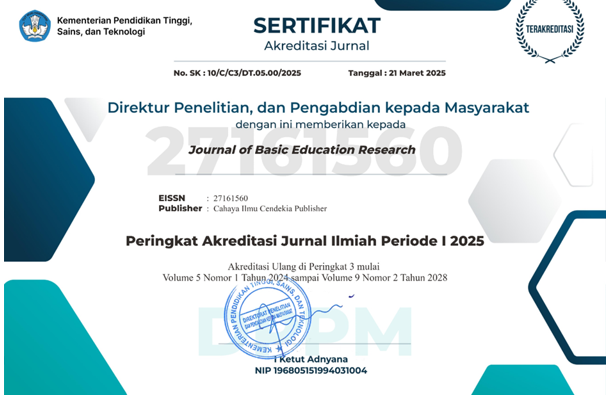Application of Local Wisdom of Wayang Figures: Building Student Character Education in Elementary Schools
Abstract
Purpose of the Study: This research aims to describe and analyze the methods of building student character by implementing local wisdom of wayang characters at Elementary School Segulung 05. It examines this process's inhibiting and supporting factors and evaluates its overall impact.
Methodology: The research adopts a case study design with a qualitative approach. Data collection techniques include observation, interviews, and documentation. Data analysis is conducted using Milles & Huberman’s method, which encompasses data reduction, data presentation, and conclusions.
Main Findings: The study reveals that character formation in students is effectively facilitated through the integration of wayang figures' local wisdom. This is achieved via strategies such as introducing wayang characters and their traits, using exemplars, narrating stories or giving advice, and incorporating wayang-related materials into Javanese language lessons. Supporting factors for this character-building process include the unique and engaging form of wayang, students' enthusiasm for listening to stories, and the broad acceptance of wayang across different societal groups.
Novelty/Originality of the Study: The novelty of this research lies in its detailed exploration of character education through the cultural medium of Wayang, showcasing innovative ways to leverage local wisdom in modern education. By integrating Wayang characters and their moral lessons into the curriculum, the study provides a unique approach to character building. This method enhances student engagement and cultural appreciation and fosters moral development through culturally resonant narratives and practical examples.
References
J. C. A. Sandoval-Rivera, “Environmental education and indigenous knowledge: Towards the connection of local wisdom with international agendas in the framework of the Sustainable Development Goals (SDGs),” Diaspora, Indig. Minor. Educ., vol. 14, no. 1, pp. 14–24, 2020, doi: 10.1080/15595692.2019.1652588.
Kamid, R. Theis, Sufri, S. E. Septi, and F. I. Putri, “Comparison of Two Learning Models on Students’ Process Skills in Elementary School,” J. Ilm. Sekol. Dasar, vol. 6, no. 3, pp. 446–457, 2022, doi: 10.23887/jisd.v6i3.48681.
D. K. Murti, G. Gunarhadi, and W. Winarno, “Development of Educational Comic with Local Wisdom to Foster Morality of Elementary School Students: A Need Analysis,” Int. J. Educ. Methodol., vol. 6, no. 2, pp. 337–343, 2020, doi: 10.12973/ijem.6.2.337.
A. Fadli and Irwanto, “The effect of local wisdom-based ELSII learning model on the problem solving and communication skills of pre-service islamic teachers,” Int. J. Instr., vol. 13, no. 1, pp. 731–746, 2020, doi: 10.29333/iji.2020.13147a.
Yusnidar, M. D. W. Ernawati, D. A. Kurniawan, M. Z. Azzahra, F. I. Putri, and N. Prameswari, “Effect Of Learning Using The Problem-Based Learning (PBL) Model With Scaffolding On Creative Thinking And Learning Independence,” J. Southwest Jiaotong Univ., vol. 58, no. 5, pp. 681–692, 2023, doi: 10.35741/issn.0258-2724.58.5.52.
M. T. Wuryani, R. Roemintoyo, and S. Yamtinah, “Textbooks Thematic Based Character Education on Thematic Learning Primary School: An Influence,” Int. J. Educ. Methodol., vol. 4, no. 2, pp. 75–81, 2018, doi: 10.12973/ijem.4.2.75.
D. Yulianti, S. Khanafiyah, and S. Sulistyorini, “Inquiry-based science comic physics series integrated with character education,” J. Pendidik. IPA Indones., vol. 5, no. 1, pp. 38–44, 2016, doi: 10.15294/jpii.v5i1.5787.
A. R. Asmi, A. N. Dhita Surbakti, and H. C., “E-Module Development Based Flip Book Maker for Character Building in Pancasila Coursework Sriwijaya University,” J. Pendidik. Ilmu Sos., vol. 27, no. 1, p. 1, 2018, doi: 10.17509/jpis.v27i1.9395.
Y. Ariyana, A. Pudjiastuti, R. Bestary, and Zamroni, Learning Oriented Handbook on Higher Order Thinking Skills. Jakara: Ministry of Education and Culture, 2018.
P. Zhang and S. Li, “Associative cultural landscape approach to interpreting traditional ecological wisdom: A case of Inuit habitat,” Front. Archit. Res., vol. 13, no. 1, pp. 79–96, 2023, doi: 10.1016/j.foar.2023.09.008.
S. Bahri, M. Ramly, A. Gani, and S. Sukmawati, “Organizational Commitment and Civil Servants Performance: The Contribution of Intelligence, Local Wisdom and Organizational Culture,” Eur. J. Bus. Manag. Res., vol. 6, no. 1, pp. 128–134, 2021, doi: 10.24018/ejbmr.2021.6.1.720.
D. Darmaji, A. Astalini, D. A. Kurniawan, F. I. Putri, R. Perdana, and F. Fuldiaratman, “Student’s need analysis in using ordinary differential equation e-module of Mathematical Physics II,” Momentum Phys. Educ. J., vol. 7, no. 1, pp. 107–115, 2023, doi: 10.21067/mpej.v7i1.7092.
E. N. S. Agustina, S. Widadah, and P. A. Nisa, “Developing Realistic Mathematics Problems Based on Sidoarjo Local Wisdom,” Math. Teach. Res. J., vol. 13, no. 4, pp. 181–201, 2021.
A. R. Muhammad, S. Suhaimi, T. Zulfikar, S. Sulaiman, and M. Masrizal, “Integration of character education based on local culture through online learning in Madras Ahaliyah,” Cypriot J. Educ. Sci., vol. 16, no. 6, pp. 3293–3304, 2021, doi: 10.18844/cjes.v16i6.6559.
M. J. Susilo, M. H. Dewantoro, and Y. Yuningsih, “Character education trend in Indonesia,” J. Educ. Learn., vol. 16, no. 2, pp. 180–188, 2022, doi: 10.11591/edulearn.v16i2.20411.
H. Sabil, D. A. Kurniawan, R. Perdana, F. I. Putri, and S. E. Septi, “The Influence of Tarompa E-Module on Peace-Loving Characters,” J. Pendidik. Indones., vol. 12, no. 2, pp. 283–292, 2023.
S. Budiarti, M. Nuswowati, and E. Cahyono, “Guided Inquiry Berbantuan E-Modul untuk Meningkatkan Keterampilan Berpikir Kritis,” J. Innov. Sci. Educ., vol. 5, no. 2, pp. 144–151, 2016.
F. A. Yusuf, “Meta-Analysis: The Influence of Local Wisdom-Based Learning Media on the Character of Students in Indonesia,” Int. J. Educ. Methodol., vol. 9, no. 1, pp. 237–248, 2023, doi: 10.12973/ijem.9.1.237.
M. Khusniati, A. P. Heriyanti, N. P. Aryani, T. R. Fariz, and D. Harjunowibowo, “Indigenous science constructs based on Troso woven fabric local wisdom: a study in ethnoscience and ethnoecology,” J. Turkish Sci. Educ., vol. 20, no. 3, pp. 549–566, 2023, doi: 10.36681/tused.2023.031.
I. W. Rasna and D. K. Tantra, “Reconstruction of Local Wisdom for Character Education through the Indonesia Language Learning: An Ethno-pedagogical Methodology,” Theory Pract. Lang. Stud., vol. 7, no. 12, p. 1229, 2017, doi: 10.17507/tpls.0712.09.
N. Azizah and S. Premono, “Identifikasi Potensi Budaya Lokal Berbasis Etnokimia Di kabupaten Bantul,” J. Trop. Chem. Res. Educ., vol. 3, no. 1, pp. 53–60, 2021, doi: 10.14421/jtcre.2021.31-06.
V. U. Pratiwi, Andayani, R. Winarni, and A. Anindyarini, “Digital Storybook to Transform Character Education of Local Wisdom Figures for Elementary School Students,” J. Soc. Stud. Educ. Res., vol. 13, no. 4, pp. 250–264, 2022.
H. Zafira and F. P. Artharina, “Pengembangan Media Wayang Tematik Pada Tema Indahnya Negeriku Sebagai Pendukung Scientific Approach Kelas Iv Sekolah Dasar,” Refleks. Edukatika J. Ilm. Kependidikan, vol. 8, no. 1, 2017, doi: 10.24176/re.v8i1.1778.
J. W. Creswell, Research Design Qualitative, quantitative, and mixed methods approaches. Thousand Oaks, CA: Sage, 2014.
J. Sopacua, M. R. Fadli, and S. Rochmat, “The history learning module integrated character values,” J. Educ. Learn., vol. 14, no. 3, pp. 463–472, 2020, doi: 10.11591/edulearn.v14i3.16139.
C. P. Sari, H. S. Zainiyati, and R. Al Hana, “Building Students’ Character through Prophetic Education at Madrasa,” J. Pendidik. Islam, vol. 6, no. 1, pp. 27–36, 2020, doi: 10.15575/jpi.v6i1.6380.
O. Nopan, “Pentingnya Pendidikan Karakter Dalam Dunia Pendidikan,” Manajer Pendidik., vol. 9, no. 3, pp. 464–468, 2015.
I. N. Suardana, I. W. Redhana, A. A. I. A. R. Sudiatmika, and I. N. Selamat, “Students’ critical thinking skills in chemistry learning using local culture-based 7E learning cycle model,” Int. J. Instr., vol. 11, no. 2, pp. 399–412, 2018, doi: 10.12973/iji.2018.11227a.
U. A. Setiani, S. Sukirno, M. Riyanton, and M. T. Kariadi, “Using Character Education Forms and Values of Folklores in Brebes Regency as the Old Literature Learning Materials,” J. Ling. Idea, vol. 12, no. 1, p. 40, 2021, doi: 10.20884/1.jli.2021.12.1.3949.
H. Amaruddin, H. T. Atmaja, and M. Khafid, “Peran Keluarga Dan Media Sosial Dalam Pembentukan Karakter Santun Siswa Di Sekolah Dasar,” J. Pendidik. Karakter, vol. 10, no. 1, pp. 33–48, 2020, doi: 10.21831/jpk.v10i1.30588.
I. Magdalena, A. S. Haq, and F. Ramdhan, “Pembelajaran Pendidikan Kewarganegaraan Di Sekolah Dasar Negri Bojong 3 Pinang,” J. Pendidik. dan Sains, vol. 2, no. 3, pp. 418–430, 2020.
P. P. Setiani, “Media Pembelajaran WARTOP (Wayang Karakter Tokoh Pahlawan) Untuk Menumbuhkan Jiwa Nasionalisme Mahasiswa IKIP Budi Utomo Malang,” Hist. J. Pendidik dan Peneliti Sej., vol. 1, no. 2, p. 17, 2018, doi: 10.17509/historia.v1i2.9749.
Roibin, E. S. Rahmawati, and I. Nurhayati, “A Model for Acculturation Dialogue Between Religion, Local Wisdom, and Power: A Strategy to Minimize Violent Behavior in the Name of Religion in Indonesia,” J. Southwest Jiaotong Univ., vol. 56, no. 1, 2021, doi: 10.35741/issn.0258-2724.56.1.1.
M. Mungmachon, “Knowledge and Local Wisdom : Community Treasure,” Int. J. Humanit. Soc. Sci., vol. 2, no. 13, pp. 174–181, 2017.
Copyright (c) 2024 Dwy Rahayyu Noritasari, Bash Asbe Edward, Hasvin Padmanathan

This work is licensed under a Creative Commons Attribution 4.0 International License.
Authors who publish with this journal agree to the following terms:
- Authors retain copyright and acknowledge that the Journal of Basic Education Research is the first publisher licensed under a Creative Commons Attribution 4.0 International License.
- Authors are able to enter into separate, additional contractual arrangements for the non-exclusive distribution of the journal's published version of the work (e.g., post it to an institutional repository or publish it in a book), with an acknowledgment of its initial publication in this journal.
- Authors are permitted and encouraged to post their work online (e.g., in institutional repositories or on their website) prior to and during the submission process, as it can lead to productive exchanges and earlier and greater citation of published work.





.png)


.png)
.png)


















